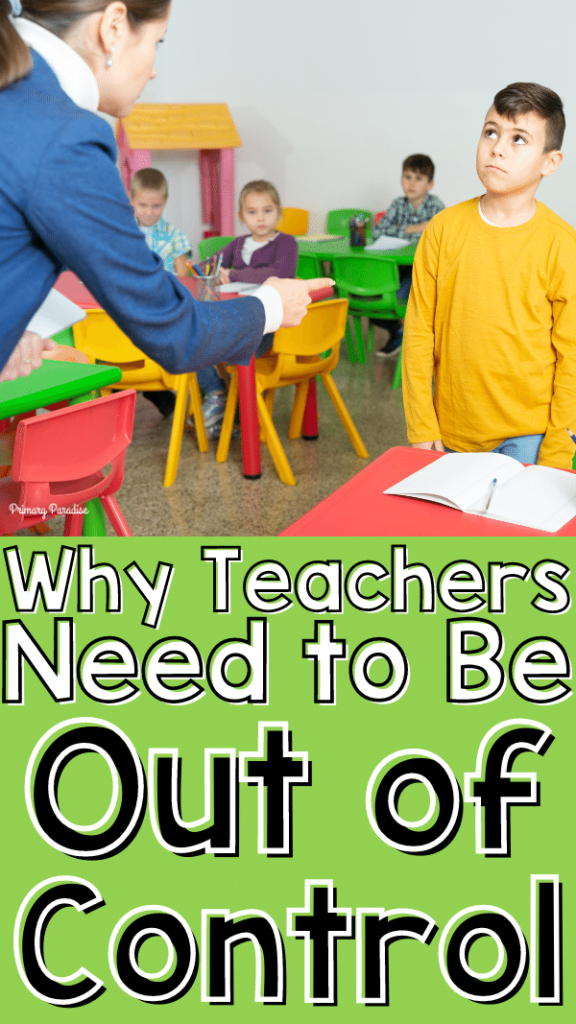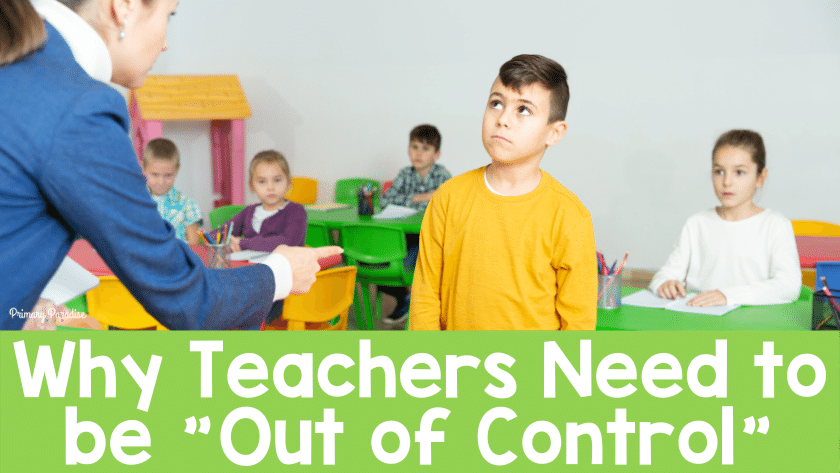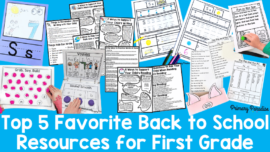Teachers tend to be control freaks. Not all, of course, but generally, elementary teachers in particular feel the need to control every aspect of their classroom. However, if order for students to really thrive, teachers need to relinquish their need for constant teacher control. Here are 7 things teachers need to stop trying to control in their classroom, and why letting go will give them more freedom.
Teachers need to give up control of students’ bodies
Criss cross apple sauce. “Listening posture”. Feet on the floor. Put a bubble in your mouth. Teachers are used to trying to control student bodies. Of course, we don’t typically see it this way, but that’s exactly what we’re doing when we tell students they must sit this way or stand that way.
If you’re thinking I’m advocating anarchy, I’m not at all. Of course, boundaries and expectations are important. However, policing exactly how students sit, stand, or walk is not the way to create a classroom environment that builds autonomy, independence, and creative thinking.
So, how to we make sure our students are being careful with their bodies? Not bothering others? Paying attention? It’s actually much simpler than telling 25 6 year olds to sit criss cross apples sauce 10 times a lesson.
Instead of trying to control how students sit and stand and move, work on setting boundaries. Does it matter if students sit a particular way? No. What does matter is that they’re not touching other people and they’re able to focus. Is it a problem is students need to stand to work? Definitely not.
As long as they’re still doing their work, it’s all good. Instead of focusing on exactly what students need to do, spend time practicing, discussing, and modeling appropriate choices. Sure, there will still be times you need to redirect your students, but you won’t have to care if Max is sitting on his knees in the back, Sarah is sitting with her legs to the side, Julian stands behind his desk to work, or Ralph is sitting with his legs tucked under him at his desk. Set boundaries and give choices rather than trying to control everything students do with their bodies.
Teachers need to give up control of things that don’t really matter
As teachers, we often want things to be a certain way. However, sometimes we spend time and energy worrying about things that don’t really matter. Instead of exerting energy on things that aren’t truly that important, focus on the things that matter. If it doesn’t impact your students’ learning, safety, wellbeing, and your ability to do your job, don’t waste time stressing about it.
Teachers need to give up control of having a perfect classroom
If you scrolls through Pinterest or Instagram, you’re going to see perfectly put together classroom. Everything probably matches. There might be a fancy theme. But, here’s the thing. It takes a lot of time, money, and effort to create those Pinterest perfect classrooms, and often times, they’re not really that student friendly.
It’s totally fine to make your classroom comfortable and nice, and you should. But, you do not need a fancy theme, matching curtains, and a rainbow organization system for students to learn. Instead, focus on creating a space that’s comfortable for your students. Give them freedom to help shape and mold the space. And, don’t pressure yourself for everything to be matchy matchy. An old bookshelf from a yard sale holds books just fine. Mismatched storage containers work just fine. Secondhand books and puzzles get the job done. And, those witty, perfect posters? Let the kids make some! They’ll love it. You’ll save money. And, they’ll feel ownership in the classroom.
Bottom line, perfect classrooms are overrated and not worth the stress.
Teachers need to give up control of tasks not worth their time
Students love to help, and there are a lot of tasks you can relinquish to them that will save you time and help them become more autonomous and independent. Sometimes we want things to be “just so” so we insist on doing them ourselves. But, a crooked bulletin board still works. A not perfectly cleaned white board is still useable. Papers slightly askew in folders never hurt anyone.
Think about tasks that you do that your students could take over. Show them how to do it, and then let them give it a try. They might surprise you with their enthusiasm and attention to detail. If something is really a catastrophe, you can either reteach how to do it, or add it back as a teacher job. But, you’ll likely find that your students are capable of a whole lot more than you realized.
Teachers need to give up control of student behavior
Okay, before you click away, here me out. I’m not saying teachers’ not need to monitor and manage student behavior. However, teachers often spend time trying to control behaviors that don’t impact learning or the classroom environment. So, teachers need to give up trying to control every aspect of student behavior.
Instead, it’s much more helpful to start the year by having students help develop classroom expectations, and then teach students to monitor their own behavior. How does this work? It’s as simple as changing demands to questions, letting certain things go, and passing control to students. I’m not saying this is easy, but I am saying that not taking behavior personally and looking at behavior from a “how can you make a different choice” stance rather than a “I need to make you do what I want” stance will make a big difference in your classroom.
Changing Demands to Questions
So, what would this look like? Here’s a simple example. Instead of “stop talking while you’re supposed to be working” you can say “what’s our classroom expectation when other students are trying to work?” Instead of “Don’t grab all of the pencils! You have to share!” you can say, “Oh no! Does everyone have a pencil to use? How can we make sure they do?”
This might feel a little odd and silly at times. And, it might feel like more work. BUT, when we ask questions instead of making demands, it has two important effects. First, it makes students stop, think, and act. They now are responsible for fixing the problem, not you. Eventually, they will begin to self correct their own behaviors. And secondly, when you do need to make a demand because it’s a safety issue or it’s a very important instruction, they won’t tune it out. They’ll know you mean business. So, save those demands for when you have to say, “Take the scissors away from her hair right now!”
Letting Things Go
Instead of policing “annoying” behaviors, try to let them go. There are plenty of things kids are called out for in schools that really do not matter. I’ve already mentioned this above a bit when we talked about policing student bodies, but it goes even further. It’s helpful to think about it the same way we ask our students to think about it before they tattle tale. If the students’ choices aren’t hurting anyone and aren’t dangerous, we should probably let them be. Does it hurt anyone if a student wants to sit on the floor instead of their desk? No, as long as they’re working and not bothering other students. Is it dangerous for a student to have their hoodie up? No, and in fact, sometimes it’s a great way for students to self soothe! We often expect more of students than we do ourselves, so before you correct a student over doodling when you’re teaching, check to see if they’re tuning you out, or if they’re just keeping their hands busy while they listen.
Pass Control on to Students
This last one is my favorite because it takes the burden off of you and gives students a sense of autonomy. Whenever possible, pass the control onto your students. There are so many things we have to regulate and control, so if there’s responsibility that we can give to the students, do it! Here are two examples.
First, let students regulate when they need a break. Creating a calm down area in your classroom, modeling appropriate times and ways to use it, and then letting students self regulate can really change the mood in your classroom. It’s not about letting kids off the hook. It’s about providing them with coping skills.
Second, let students control when they take bathroom breaks. Although the rules and set up of your school might impact this somewhat, this is a big one. Create a system, like a sign out sheet or check out board, so, when students need to use the restroom, they can see if anyone is out, sign out, go, and check back in when they come back. Of course, it’s fine to have times that are “only go if it’s an emergency” time, but giving students control over bathroom breaks means less hands up asking to use the bathroom for you. Again, if this isn’t how previous teachers do it, it might seem novel to students at first, but after a while, they’ll get used to it and it won’t be a big thing.
Teachers need to give up control of students’ homes and family lives
One of the biggest mistakes new teacher make is thinking they need to “save” their students or assuming that their students’ parent’s aren’t invested in their student’s learning. They blame all of their students’ issues on their home life, or assume that just because students’ home lives look different than what they’re used it, somehow it’s lacking. Or, they spend countless hours worrying about what happens at home. Of course, if you have cause for concern about students being mistreated or abused, you should report that to the proper authorities. However, overall, teacher’s need to give up worrying about students’ family lives. You can try your best to connect with parents, give them math and reading support, and form a relationship with them, but ultimately, you can only control what happens in your classroom, so that’s where your time, energy, and focus should go.
Teachers need to accept that they can’t control everything
Lastly, overall, teachers need to accept that we can’t control everything. It is better for our students, our students’ families, our families, and our mental health if we can accept that fact. It’s better to spend your time and energy on the things that actually matter.
You might also enjoy:
Helping Students Resolve Conflicts So They Can Take Ownership
How Class Jobs Work in my First Grade Classroom
How to Create a Morning Routine that Sets Your Class Up for Success
The Secret to Creating the Most Meaningful Learning Experiences




